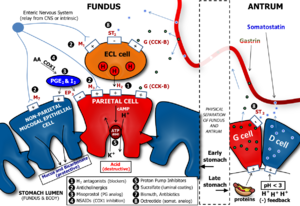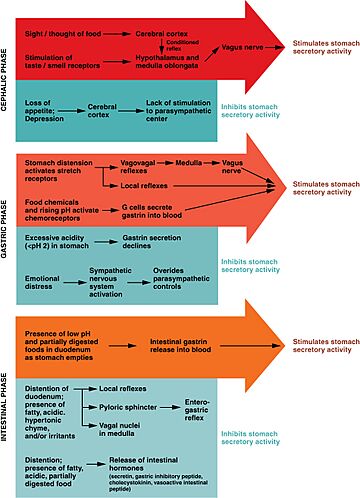Gastric acid facts for kids
Gastric acid, also known as stomach acid, is a very strong and important fluid made in your stomach. It is mostly made of hydrochloric acid. This acid has a pH level between 1 and 3, which is more acidic than lemon juice!
Stomach acid has two main jobs. First, it helps with digestion by breaking down the proteins in your food. Second, it acts like a security guard, protecting your body by killing harmful pathogens (germs) that you might swallow with your food or drinks.
Your body has a clever system to control this powerful acid. The stomach lining is protected by a thick layer of mucus so the acid doesn't damage it. Other parts of your digestive system also help to neutralize the acid once it leaves the stomach.
Contents
What Does Gastric Acid Do?
Gastric acid is a key player on your body's digestion team. It works with other substances in the stomach, which are all part of a mixture called gastric juice.
Breaking Down Food
One of the main jobs of gastric acid is to help break down proteins from food like meat, beans, and eggs. It does this by activating a special digestive enzyme called pepsin.
Think of pepsin as a pair of tiny scissors. Before the acid arrives, these scissors are closed and can't do anything. This inactive form is called pepsinogen. When stomach acid is released, it "opens" the scissors, turning pepsinogen into active pepsin. Pepsin then gets to work, snipping the long chains of proteins into smaller pieces called amino acids, which your body can absorb and use.
Fighting Germs
Your stomach is the first line of defense against germs that enter your body through your mouth. The high acidity of the stomach acid kills most of the bacteria and viruses that might be in your food or water. This helps prevent you from getting sick from food poisoning and other infections.
How the Stomach Makes Acid
Making stomach acid is a complex and energetic job performed by special cells in the stomach lining called parietal cells. These cells have tiny pumps that work hard to secrete the strong acid into the stomach.
The body is very efficient and usually only makes a small amount of acid between meals. When you start to eat, these cells get a signal to ramp up production. A typical adult stomach can make about 1.5 liters of gastric juice every day!
Controlling the Acid Levels
Your body needs to control when and how much stomach acid is made. If it made too much all the time, it would waste energy and could cause problems. This control process happens in three phases and is managed by your brain, nerves, and hormones.
Phase 1: The Brain Phase
This phase starts before you even take a bite of food! Just thinking about, smelling, or seeing delicious food sends signals from your brain down a long nerve called the vagus nerve. This nerve tells your stomach to get ready and start producing acid. This phase accounts for about 30% of the acid made for a meal.
Phase 2: The Stomach Phase
Once food enters your stomach, it stretches the stomach walls. This stretching, along with the presence of amino acids from the food, signals the stomach to make even more acid. This is the main phase, responsible for about 60% of the total acid produced for a meal.
Phase 3: The Intestine Phase
As the partially digested food (now a thick liquid called chyme) moves from the stomach into the small intestine, the final phase begins. The intestine senses the chyme and sends signals that tell the stomach to produce the last 10% of the acid needed for the meal.
Protecting the Body from Acid
If stomach acid is strong enough to dissolve food, why doesn't it dissolve the stomach itself? The body has two amazing ways to protect itself.
First, the inside of the stomach is coated with a thick layer of mucus. This slimy layer acts as a powerful shield, preventing the acid from touching and damaging the stomach wall.
Second, when the acidic food mixture leaves the stomach and enters the first part of the small intestine (the duodenum), the acid must be neutralized. The pancreas releases a substance called bicarbonate, which is the opposite of an acid (a base). When the acid and bicarbonate mix, they cancel each other out, creating harmless salt and water. This protects the intestines, which do not have the same thick mucus lining as the stomach.
When Acid Levels Are Unbalanced
Sometimes, the body's system for managing stomach acid can have issues.
- Acid Reflux: This is a common condition, often called heartburn. It happens when the muscle at the top of the stomach doesn't close properly, allowing stomach acid to flow back up into the esophagus (the tube connecting your throat to your stomach). This causes a burning feeling because the esophagus isn't protected from the acid like the stomach is.
- Too Little Acid: It's also possible to have too little stomach acid. This can make it harder to digest food properly and can increase the risk of infections because there isn't enough acid to kill all the germs in food.
A Window into the Stomach: A True Story
The role of stomach acid in digestion was a mystery for a long time. It was finally proven in the 1820s by an American doctor named William Beaumont.
He treated a man named Alexis St. Martin, who had been in an accident that left a hole in his stomach that never fully healed. This hole, called a fistula, allowed Dr. Beaumont to look directly inside St. Martin's stomach. He could take samples of gastric acid and watch how food was digested. Through his experiments, Dr. Beaumont was the first to prove that acid, not just the stomach's mashing motion, was a key part of digestion.



